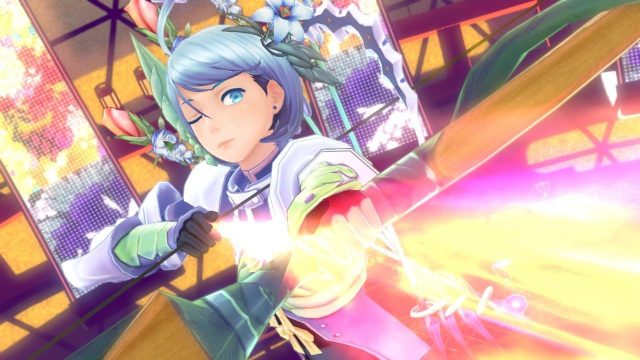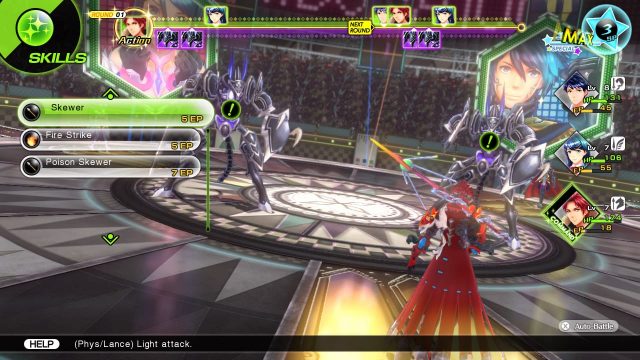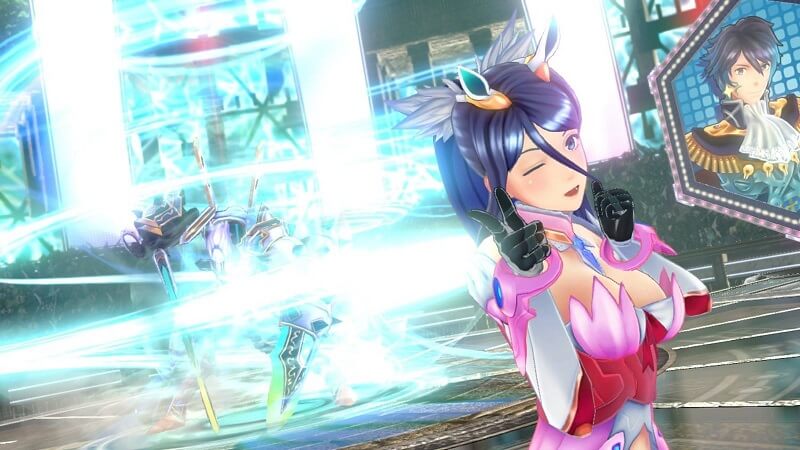The life of an employee of Fortuna Entertainment is just like its namesake. Every actor seems blessed to summon a spirit guide of sorts called Mirages who can fight for them and become their literal sword and shield (and spear, and microphone stand wand, etc.). At the same time, they face real-life problems like choosing whether or not to break their cool and calm persona image to temporarily star in a kid’s show wearing a cat suit. The road to stardom is fraught with hard work and peril, but as long as you keep your chin up and believe in friendship, you’ll make it far.
Welcome to the wacky world of Tokyo Mirage Sessions #FE. It’s a mouthful of a title and sure as hell glamorizes the Japanese pop industry to the point of sickly saturation, but those are the only glaring issue I had with this Wii U masterpiece of an RPG title.
Let’s Dance
Players control Itsuki Aoi, a student who somehow got wrapped up with watching his childhood friend Tsubasa Oribe perform for a talent scouting show in Tokyo. Pretty soon, they get sucked into a shadowy plane of existence called an Idolasphere and end up becoming Mirage Masters, warriors who moonlight as entertainers to rid the world of rogue mirages. In the world of TMS#FE, spiritual energy called Performas help make the world go round and being a pop star entertainer means you have grade A levels of it.

As with most JRPGs, you explore these Idolaspheres to complete quests and solve problems to forward the plot along, finding out why evil mirages are more commonplace than before and also uncovering the mysteries of a 5-year old mass disappearance which Tsubasa was caught up in.
These problems usually are solved with turn-based combat where you channel the power of mirages based on Fire Emblem characters like Chrom and Cain (hence the #FE part of the title) and combat mirages straight out of a Shin Megami Tensei title. Oh, did I not mention that the game is a crossover between Shin Megami Tensei and Fire Emblem?
It’s the theme that sets this one apart from everything else: the place is set in contemporary Tokyo in the busiest parts of Shibuya, your curatives are energy drinks and stuff you find in the vending machines, your stat buffs come from accessories. You sometimes converse with your party via the world’s equivalent of Whatsapp on the Wii U tablet, hearing their opinions on a current matter or just venting their thoughts at you since you’re the leader and all. It’s immersive stuff you can get behind that can get you invested bit by bit.
Blame It On The Boogie
In keeping with the performance motif of the game, your characters can chain up attacks called “Sessions” during combat. When you exploit an enemy weakness, your party members will jump in and perform attacks of their own to capitalize on the damage with spells and special moves of their own.
Sometimes, you can perform beefed-up versions of your special attacks called Ad Lib performances depending on your Luck stats. Halfway through a Session, you can also perform Duet moves which are not only powerful area-of-effect moves done by two members of your party, but also opens up another chance for a new Session. You can also pull off super moves which uses up SP meter (indicated on the top right) that can also, you guessed it, bring in more Sessions.

It’s here where the game is at its most liveliest. There is nothing more satisfying and absurd than seeing your min-maxing and character-building exercise pay off with a 5-hit combo capped off with two of your pals suddenly in bright cabaret outfits forming damaging projectiles and beams in a shape of a heart. These Sessions and Duet moments can be lifesavers too: the tougher bosses here can act more than twice at times, so chaining up attacks that can also buff you midway can help in these trying fights.
It’s a good thing too: some of the environments you wander around in seem too conventional even with the sorta-demonic interior deco going on. The brunt of the action is the combat arena staged up like an actual concert with an audience and a ton of spotlights & props: impressive spectacle all around. The dungeons themselves have mini-puzzles in them that require you to jot down clues and patterns on a separate piece of paper. The caveat? Re-doing dungeons for sidequests require you to go through these puzzles again and again. While not mind-numbingly hard to crack, repeatedly going through the same corner to turn on switches to reposition makeshift bridges can wear on you.
Jump Jive & Wail
You won’t get far in the game if you don’t use the game’s Bloom Palace: an alternate dimension place within the Fortuna Entertainment office where you get your character and mirage upgrades. To get better weapons for fighting and extra character skills, you have to talk to a Hatsune Miku-inspired character named Tiki.
You then take the required spoils from your dungeon-trekking and perform a Carnage Unity ritual with them to create new armaments that grant you new active and passive skills, or a Radiant Unity that gives individual party members more buffs like an escape-from-dungeon spell or more opportunities to build up your Sessions and SP coup de grâce.
Being in the entertainment business means that you have to mingle and put up with your bosses and colleagues. The cast of TMS#FE are also a big part of its appeal: they’re anime tropes fleshed out and written very well. Yes, the people you spend your whole time with are not new types of characters: the naive-but-determined female protagonist, the cool-and-aloof-yet-awkward veteran, the well-endowed boss lady past her prime, the hothead with the heart of gold, the child prodigy, the arrogant foreigner, and so forth.
But throughout the main story and their side tales (which contributes to each member’s personal growth in and out of combat), you will grow to love them. They’re not perfect, but they have the best of intentions to do what they do, be it save the world or perfect their craft by legitimate means possible. In a strange way, they’re relatable to a point. While all the side stories are entertaining and heartfelt in their own way, I’m rather fond of Kiria’s breaking-out-of-her-shell storyline and Mamori’s tale where she attempts to inject new life in her typecasted “Microwavin’ With Mamori” role. You are sure to find your favorite subplot and character throughout the 60 hours+ gameplay this RPG has to offer.
That’s Showbiz!
Remember that bit earlier where I mentioned how the game’s narrative sugarcoats the entertainment industry? Perhaps “glamorize” is too strong a word, but the whole game’s story’s conflicts are usually solved with the power of friendship and never giving up, which can sound a bit repetitive on paper. But it’s done well here that it just seems more like nitpicking on my part. Not every game needs to take a turn to the dark, gritty, and realistic side, so it’s nice to have an RPG with a more optimistic aura to it.
Simply put, Tokyo Mirage Sessions #FE is a lovely experimental mix from the companies behind the Shin Megami Tensei and Fire Emblem series of RPGs. It’s colorful and fluffy without being too empty-headed and hollow, its fights are frenetic and fast-paced while rewarding smart play, and its cast is an eclectic group you really want to hang out with, quirks and all.
GEEK REVIEW SCORE
Summary
If you need another good reason to buy a Wii U in 2016, here’s one more. Tokyo Mirage Sessions #FE does not miss a beat when it comes to combining a fantastical pop star-themed contemporary RPG experience.
Overall
9/10
-
Gameplay - 9/10
9/10
-
Story - 9/10
9/10
-
Presentation - 9/10
9/10
-
Value - 9/10
9/10














